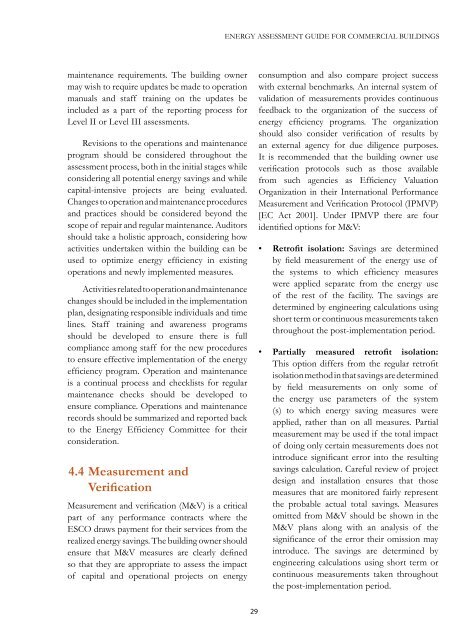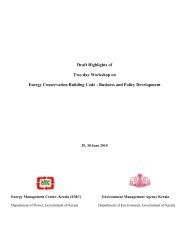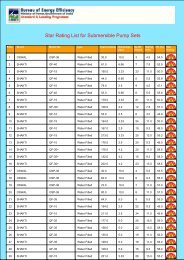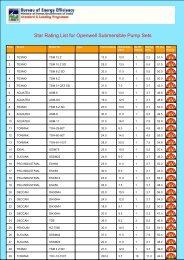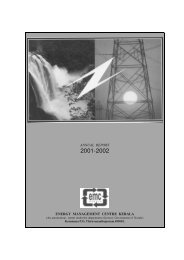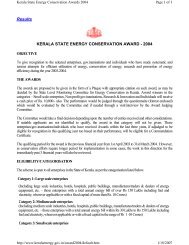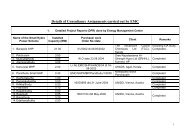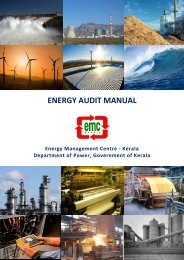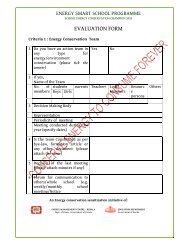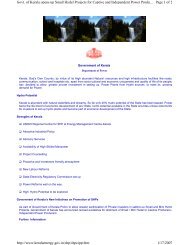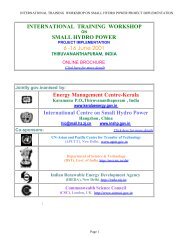energy assessment guide for commercial buildings - ECO-III
energy assessment guide for commercial buildings - ECO-III
energy assessment guide for commercial buildings - ECO-III
Create successful ePaper yourself
Turn your PDF publications into a flip-book with our unique Google optimized e-Paper software.
ENERGY ASSESSMENT GUIDE FOR COMMERCIAL BUILDINGS<br />
maintenance requirements. The building owner<br />
may wish to require updates be made to operation<br />
manuals and staff training on the updates be<br />
included as a part of the reporting process <strong>for</strong><br />
Level II or Level <strong>III</strong> <strong>assessment</strong>s.<br />
Revisions to the operations and maintenance<br />
program should be considered throughout the<br />
<strong>assessment</strong> process, both in the initial stages while<br />
considering all potential <strong>energy</strong> savings and while<br />
capital-intensive projects are being evaluated.<br />
Changes to operation and maintenance procedures<br />
and practices should be considered beyond the<br />
scope of repair and regular maintenance. Auditors<br />
should take a holistic approach, considering how<br />
activities undertaken within the building can be<br />
used to optimize <strong>energy</strong> efficiency in existing<br />
operations and newly implemented measures.<br />
Activities related to operation and maintenance<br />
changes should be included in the implementation<br />
plan, designating responsible individuals and time<br />
lines. Staff training and awareness programs<br />
should be developed to ensure there is full<br />
compliance among staff <strong>for</strong> the new procedures<br />
to ensure effective implementation of the <strong>energy</strong><br />
efficiency program. Operation and maintenance<br />
is a continual process and checklists <strong>for</strong> regular<br />
maintenance checks should be developed to<br />
ensure compliance. Operations and maintenance<br />
records should be summarized and reported back<br />
to the Energy Efficiency Committee <strong>for</strong> their<br />
consideration.<br />
4.4 Measurement and<br />
Verification<br />
Measurement and verification (M&V) is a critical<br />
part of any per<strong>for</strong>mance contracts where the<br />
ESCO draws payment <strong>for</strong> their services from the<br />
realized <strong>energy</strong> savings. The building owner should<br />
ensure that M&V measures are clearly defined<br />
so that they are appropriate to assess the impact<br />
of capital and operational projects on <strong>energy</strong><br />
consumption and also compare project success<br />
with external benchmarks. An internal system of<br />
validation of measurements provides continuous<br />
feedback to the organization of the success of<br />
<strong>energy</strong> efficiency programs. The organization<br />
should also consider verification of results by<br />
an external agency <strong>for</strong> due diligence purposes.<br />
It is recommended that the building owner use<br />
verification protocols such as those available<br />
from such agencies as Efficiency Valuation<br />
Organization in their International Per<strong>for</strong>mance<br />
Measurement and Verification Protocol (IPMVP)<br />
[EC Act 2001]. Under IPMVP there are four<br />
identified options <strong>for</strong> M&V:<br />
• Retrofit isolation: Savings are determined<br />
by field measurement of the <strong>energy</strong> use of<br />
the systems to which efficiency measures<br />
were applied separate from the <strong>energy</strong> use<br />
of the rest of the facility. The savings are<br />
determined by engineering calculations using<br />
short term or continuous measurements taken<br />
throughout the post-implementation period.<br />
• Partially measured retrofit isolation:<br />
This option differs from the regular retrofit<br />
isolation method in that savings are determined<br />
by field measurements on only some of<br />
the <strong>energy</strong> use parameters of the system<br />
(s) to which <strong>energy</strong> saving measures were<br />
applied, rather than on all measures. Partial<br />
measurement may be used if the total impact<br />
of doing only certain measurements does not<br />
introduce significant error into the resulting<br />
savings calculation. Careful review of project<br />
design and installation ensures that those<br />
measures that are monitored fairly represent<br />
the probable actual total savings. Measures<br />
omitted from M&V should be shown in the<br />
M&V plans along with an analysis of the<br />
significance of the error their omission may<br />
introduce. The savings are determined by<br />
engineering calculations using short term or<br />
continuous measurements taken throughout<br />
the post-implementation period.<br />
29


